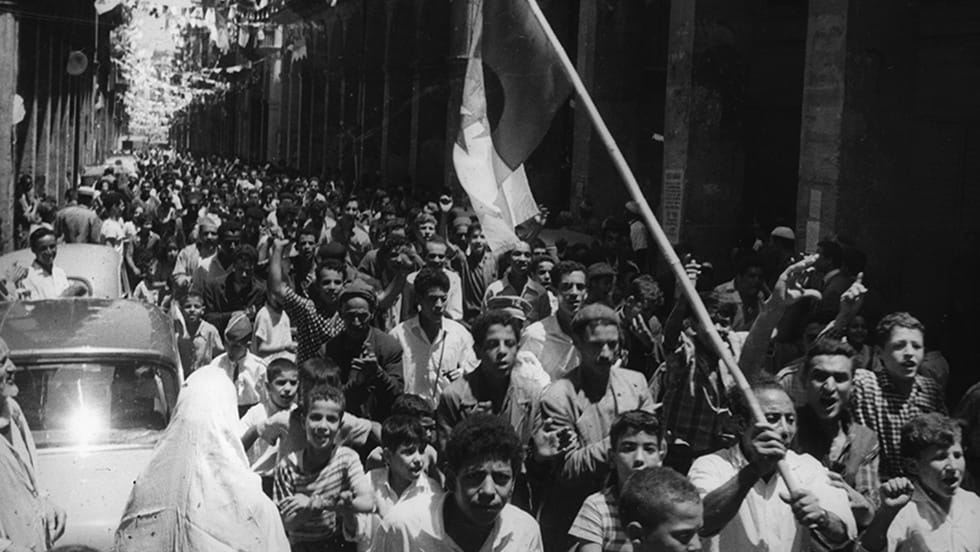Summary
Algeria's independence on 5th July 1962 was the result of over a century of French occupation and a brutal 8-year war (1954-1962) led by the National Liberation Front (FLN), characterized by guerrilla warfare and significant loss of life.
The Sétif massacre in 1945 and subsequent severe French retaliation fueled the Algerian resistance. Throughout the war, French forces committed numerous war crimes, which galvanized Algerian fighters and shifted international opinion against French colonial rule.
The war ended with the Évian Accords on 18th March 1962, granting Algeria full sovereignty. A referendum on 1st July 1962 confirmed the desire for independence, leading to Algeria officially becoming an independent state on 5th July 1962.
Deep Dive
On 5th July, 1962, Algeria declared its independence from France after over a century of French occupation. However, this victory was the result of decades of vigorous resistance and a decisive war that lasted nearly 8 years. The latter, known as the Algerian War for Independence, was launched by the National Liberation Front (FLN) on 1st November, 1954. The war was characterised by guerilla warfare and war crimes, which cost Algeria an estimated 1.5 million lives according to Algerian historians.
In this article, we will look into the events that led to the Algerian War for Independence (AKA ‘The Algerian War’) and how Algerians were able to secure their freedom from France.
Background
In 1830, the French invaded Algeria, under the leadership of Thomas Robert Bugeaud, a high-ranking military officer who later became the first Governor-General of Algeria. Four years later, Algeria was declared a French military colony. French Algeria became a destination for hundreds of thousands of European immigrants, consequently displacing several native Algerians from their rightful lands and properties.
During the first 30 years of the conquest, between 500,000-1,000,000 Algerians, out of a population of about 3 million, lost their lives, compared to 100,000 French losses. It is worth noting that not all of the Algerian deaths were as a result of warfare, as a locust plague and famine killed many Algerians too.
Even though the warfare-related deaths slowed after France established dominance in Algeria, the Muslim locals grew increasingly frustrated by their political, economic and social oppression. The European settlers (called colons or pied-noirs) owned majority of the country’s arable land and controlled the bulk of its wealth, even though they were only one-eighth of the total population. Additionally, France imposed significantly higher taxes on the Muslim locals than on pied-noirs. Locals were also deprived of education, since the colonial state refused to allocate sufficient funds to their religious schools (called madrasahs). Consequently, the literacy rate amongst the Muslim population plummeted.
In December 1942, Ferhat Abbas, who would later become the president of independent Algeria, drafted an Algerian Manifesto seeking recognition of the country’s political autonomy. A year later, General Charles de Gaulle declared that France was obligated to the Muslims of North Africa on account of the loyalty they had shown in the ongoing Second World War. Consequently, French citizenship was extended to some Algerian Muslims, but this was not enough to satisfy the Algerian masses.
In May 1945, a display of Algerian nationalist flags in Sétif, a town in northeastern Algeria, prompted French authorities to shoot at demonstrators. Algerians retaliated with an uprising which saw the massacre of 84 pied-noirs. The response of the French was infinitely more severe, resulting in the deaths of as many as 45,000 Muslim Algerians according to Algerian historians. French sources tended to grossly underreport Algerian deaths in conflicts.
Although Algeria already had a long history of resisting French occupation, many historians argue that these horrific massacres were the foundation for the Algerian War for Independence that began nearly a decade later. Sorely wounded, the Algerians lost interest in peacefully seeking their independence, but were instead charged to wage a full-on war.
The Algerian War
The FLN was an offshoot of the Special Organisation (OS), a radical paramilitary group which had been discovered by the colonial police in 1950 and subsequently disbanded. Under the leadership of Hocine Aït-Ahmed, Ahmed Ben Bella, Mohamed Boudiaf and 6 others, the FLN organised several men in the first armed confrontations with the French during the War.
They started by issuing a leaflet stating that their aim was to restore the sovereignty of Algeria. On home grounds, their strategy to achieve this goal would be guerrilla warfare, while abroad, they would try to get other countries diplomatically involved. The latter would be achieved by associating the war to the broader context of Cold War so that Algeria could gain support in the Eastern (Communist) Bloc. They also sought to make the war a topic of discussion at the United Nations, so that France would lose support for its colonisation.
The Algerians’ first armed assault kicked off at Batna and the Aurès, a mountainous region in northeastern Algeria. The attacks then spread out gradually throughout the country such that France had to deploy about two million troops over the course of the war. In an effort to curb the spread of the uprising, the French National Assembly declared a state of emergency over the entire country.
A momentous turn in the war happened in August 1955, when a sweeping armed outbreak in Skikda, also in the northeastern region, led to the bloodshed of nearly 100 European settlers and Muslim officials. In retaliation, the French army and settlers killed between 1,200 (according to French sources) and 12,000 (according to Algerian sources) Algerians.
In January 1956, Guy Mollet, a socialist politician, was elected as the premier of France. Mollet installed Robert Lacoste as the resident minister of Algeria. Under Lacoste, 500,000 troops were sent to Algeria to combat rebel strongholds in the more distant parts of the country. Meanwhile, the rebels went about collecting monetary contributions for their cause and lashed out at Muslims who failed to cooperate.
Between August-September 1956, the FLN held their first congress in northeastern Algeria to assess the progress of the war and lay out their aims and objectives. They divided the country into 6 autonomous zones which were to be led by guerrilla commanders. They also set up the National Council for the Algerian Revolution (Conseil National de la Révolution Algérienne) and the Committee for Coordination and Enforcement (Comité de Coordination et d’Éxecution).
Also in 1956, the French decided to grant Morocco and Tunisia independence whilst still holding on to Algeria. The Moroccan sultan and Tunisian premier then agreed to meet up with some of the FLN leaders (including Ben Bella and Aït-Ahmed) to devise a solution to the Algerian struggle. Unfortunately, French intelligence officers caught wind of this planned rendezvous and diverted the plane which had the Algerian leaders to Oran (in Algeria) instead of the Tunisian capital. Upon landing, the Algerian leaders were arrested and detained in prison in France for the rest of the war. This act only fuelled the rest of the Algerian leadership to fight harder. Not too long after, they killed 40 French settlers in an attack on Meknès, Morocco.
From 30th September 1956, the FLN launched a campaign in Algiers, the capital and largest city of Algeria, in a bid to bring more attention to their plight. The so-called Battle of Algiers began with three women, including Djamila Bouhired, simultaneously placing bombs at three public sites in the city. The battle continued with several bombings and shootings that affected both military and civilian European targets. French General Jacques Massu was instructed to use any means necessary to stem the FLN attacks and that he did. Massu deployed paratroopers to strike the rebels. Hundreds of suspects were summarily executed, over 24,000 Algerians were arrested and as many as 3,000 went missing. As for FLN leaders, they had two choices: flee or get killed in the cruellest of ways.
The Battle of Algiers ended in French victory on 24th September, 1957, but this was by no means the end of the war. The French’s reprehensible actions not only galvanised many more of the Algerian masses to fight, but also garnered international sympathy for the Algerians’ plight. Back in France, the French public, appalled by the reports they had received, began to consider pulling away from Algeria.
All in all, the War saw the French commit numerous war crimes such as: deliberate bombing and killing of unarmed civilians, rape, torture methods like electroshock and waterboarding, and ‘death flights’. The latter act involved dropping victims from aircraft into oceans, large rivers or mountains. The French also starved prisoners and buried them alive.
Resolution and Independence
In June 1958, Charles de Gaulle, who was now the Prime Minister of France, journeyed down to Algeria and made an emotional appeal to all its inhabitants. De Gaulle pacified the pied-noirs and French army by exclaiming ‘Vive l’Algérie française’ (‘Long live French Algeria’). Simultaneously, he appeased the Muslim locals by granting them the full rights of French citizenship. This swayed the Muslims against the FLN-led rebellion. Still, the FLN set up the Provisional Government of the Algerian Republic (GPRA) in Tunis.
In February of the following year, de Gaulle was elected president of the new Fifth Republic of France. Not too long after, he visited Constantine, a major city in eastern Algeria, to announce his plans to end the war and establish an Algeria that was closely tied to France. He called on the GPRA, headed by Abbas, to support a cease-fire and participate in elections for the new Algerian government. However, the GPRA adamantly refused as they felt it wasn’t enough for the violence to end; negotiations for Algeria’s independence had to follow.
On 16th September, de Gaulle publicly proposed granting Algeria the right to self-determination as one of the solutions to the end of the war. This was essentially a call for negotiation, but the French government refused to recognise the GPRA as the representative of Algeria’s Muslim community.
Meanwhile, the settler population was vehemently against the idea of negotiation and responded by staging a revolt in January 1960. However, with no support from the military, the revolt ended after 9 days. A year later, as negotiations became more likely to happen, another revolt was organised by four French generals but it also failed.
Finally, in May 1961, negotiations began in France with GPRA representatives. Back in Algeria, pied-noirs, together with an organisation called the Secret Army Organisation (OAS), once again revolted in a bid to disrupt the negotiations. Negotiations resumed the following year and on 18th March,1962, a set of peace treaties called the Évian Accords ended the war with a cease-fire. The treaties also included agreements to prisoner releases, and the recognition of full sovereignty and right to self-determination of Algeria.
From then on, there was a transitional period which ended with the referendum of self-determination on 1st July, 1962. An overwhelming majority (99.72%) of the French electorate voted in favour of self governance and thus, Algeria officially became an independent state on 5th July of the same year. This was a significant date as it marked the 132nd anniversary of the day when the city of Algiers surrendered to French occupiers in 1830.

Oyindamola Depo Oyedokun
Oyindamola Depo Oyedokun is an avid reader and lover of knowledge, of most kinds. When she's not reading random stuff on the internet, you'll find her putting pen to paper, or finger to keyboard.
follow me :
Leave a Comment
Sign in or become a Africa Rebirth. Unearthing Africa’s Past. Empowering Its Future member to join the conversation.
Just enter your email below to get a log in link.

